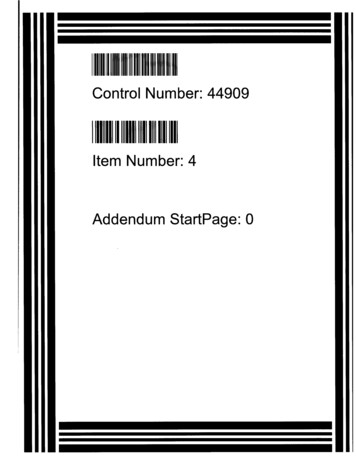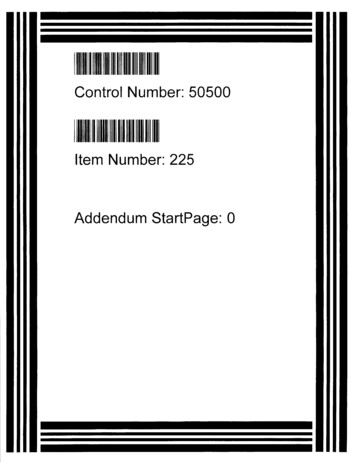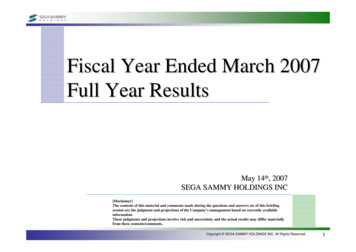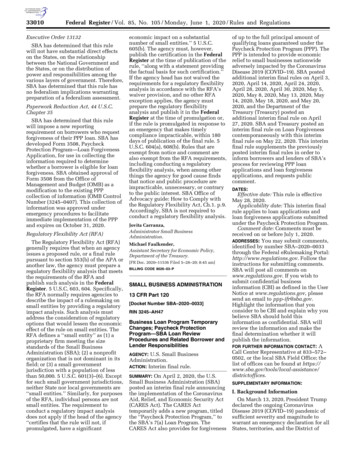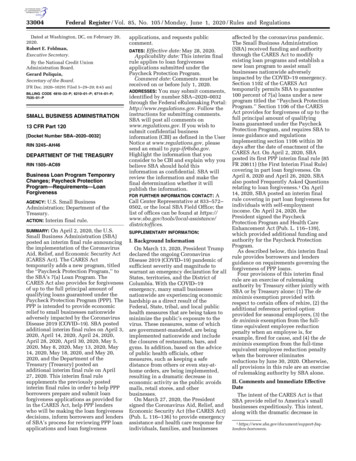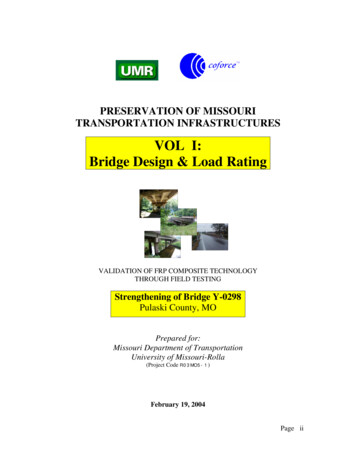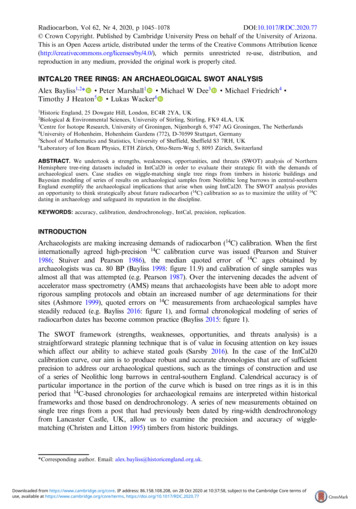
Transcription
ISSN 0798 1015HOMERevista ESPACIOS !ÍNDICES !A LOS AUTORES !Vol. 39 (Number 12) Year 2018. Page 22Methods of analysis of the externalenvironment of business activitiesMétodos de análisis de entorno externo de las actividadescomercialesTatyana V. SHTAL 1; Mykhailo M. BURIAK 2; Yerzhan AMIRBEKULY 3; Galiya S. UKUBASSOVA 4; TlegenT. KASKIN 5; Zukhra G. TOIBOLDINOVA 6Received: 10/01/2018 Approved:29/01/2018Contents1. Introduction2. Materials and methods3. Results and discussion4. ConclusionsBibliographic referencesABSTRACT:RESUMEN:The urgency of the business activity externalenvironment analysis is due to the fact that the modernexternal environment of enterprises is characterized byan extremely high degree of dynamism, complexity, anduncertainty. Thus, the main condition in business, aswell as in other areas of life, is the ability to adapt tochanges taking place in the external environment. Animportant condition is that organizations must respondto new changes taking place in the externalenvironment effectively and timely. Different methodsof strategic analysis are considered in this article,namely: SWOT analysis, PEST analysis, STEP analysis,GRID matrix, SNW analysis, EFAS form and others thatallow estimating the factors influencing the externalenvironment of the market on the basis of whichorganizations can make effective decisions. The articlehighlights the advantages and disadvantages ofmethods.Keywords: Organization, macro environment, theexternal environment factors, SWOT analysis, PEST analysis.La urgencia del análisis del entorno externo de laactividad empresarial se debe a que el entorno externomoderno de las empresas se caracteriza por un altogrado de dinamismo, complejidad e incertidumbre. Porlo tanto, la principal condición en los negocios, así comoen otras áreas de la vida, es la capacidad de adaptarsea los cambios que tienen lugar en el entorno externo.Una condición importante es que las organizacionesdeben responder a los nuevos cambios que tienen lugaren el entorno externo de manera efectiva y oportuna.En este artículo se consideran diferentes métodos deanálisis estratégico, a saber: análisis FODA, análisisPEST, análisis STEP, matriz GRID, análisis SNW,formulario EFAS y otros que permiten estimar losfactores que influyen en el entorno externo del mercadosobre la base de qué organizaciones puede tomardecisiones efectivas El artículo destaca las ventajas ydesventajas de los métodos.Palabras clave: Organización, entorno macro, factoresdel entorno externo, análisis FODA, PEST - análisis.
1. IntroductionFor today, the external environment analysis of business activities takes a very important placein the development of any organization. This is due to the fact that the modern externalenvironment of enterprises is characterized by an extremely high degree of dynamism,complexity, and uncertainty. In addition, one of the main conditions in business, as well as inother areas of life, is the ability of the organization to adapt to external changes in the macroenvironment. You can add that any organization exists and functions in conjunction with manyfactors. These factors have a different impact on organization and have a very significantimpact on the organization’s capabilities, its perspectives and strategy. The combination ofinteraction factors is considered as an organization environment in management.Today, in management and marketing, there are many thoughts about the role of variousmethods of analysis. The existing methods currently available for exploring the macroenvironment were analyzed in this article.A large number of methods for assessing the factors of the external market functioningprovides a wide opportunity to develop possible options for market entry strategies.A large number of studies have been carried out on the methods of analysis of the externalbusiness environment, and many researchers have been involved in systemic research,including F. S. Akillyar, I. Ansoff, F. E. Cast, J. E. Rosenweig, A. Humphrey, T. Whellen, D.Hunger, Ye. Panchenko, A. Starostina, T. Tsygankova, Ya.O. Polyakova, O. Yevdochenko, I.Dyukov (Balabanova, 2005, p. 205-207; Polonets, 2006, p. 47-50; Saray, 2010, p. 160-163;Golovko and Sagovaya, 2002, p. 44-49; Whellen and Hunger, 1992, p. 92; Danko andSkorobogatykh, 2005, p. 84; SWOT Analysis is a , Follow a SWOT , SWOT Analysis).2. Materials and methodsA complex of general scientific methods and methods of research became the scientifictheoretical and methodological basis of this article. System analysis was used to identify thefeatures of the external environment of business activities analysis methods. To compare theresulted methods, as well as to identify their advantages and disadvantages, comparativeanalysis, expert analysis, synthesis and generalization methods were used.3. Results and discussionLet us consider one of the most common methods of analysis - SWOT. There are many of itsmodifications in the literature. This method was developed by Albert Humphrey. Thanks to thismatrix you can identify the weaknesses and strengths, as well as opportunities and threats. Theadvantage of the method is that it allows you to make strategically important decisions for theorganization. By defining the company’s capabilities with this method, one can say that: whichnew product can organization make; can an organization conquer new customers, introduce anew production technology, and also have resources to build and improve a chain of values.This method allows us to identify those factors that may cause damage to the enterprise, thatis, threats (Thompson and Strickland, 2006, p. 61; Polonets, 2006, p. 14; Apple SWOTAnalysis; Coca Cola SWOT Analysis). (Fig. 1).The SWOT analysis matrix is filled in according to the following principle:1. "S" field - defines the strengths of the enterprise, through which you can determine thestrategic direction of the enterprise, as well as make strategically important decisions.2. "W" field - determines which strengths an organization can use to reduce its threats.3. "O" field - defines the possibilities of the enterprise in the presence of a large number ofweaknesses.4. "T" field - defines the vulnerable weaknesses of the enterprise in conditions of threats
(Balabanova, 2005, p. 56; Saray, 2010, p. 49; PESTLE Analysis of Uber).Figure 1SWOT analysis matrixThe advantage of this method is its ease of use, as well as a wide range of applications whenusing it, without having to spend a lot on marketing research. The disadvantage of this methodis that it is impossible to trace the dynamics of time changes in the market, the inaccuracy ofthe analysis results.International companies such as Apple, BMW, Coca Cola can be an example of using SWOTanalysis (PEST Analysis for Micro ; PESTLE Analysis of Starbucks; A PESTLE Analysis of Nike).РЕЅТ analysis is no less widespread and widely used method of analysis (Saray, 2010, p. 18;Danko and Skorobogatykh, 2005, p. 8; SWOT Analysis is a ; Balabanova, 2005, p. 118-119;Polonets, 2006, p. 48; Difference between SWOT ; PESTLE Analysis of Uber). There are fourblocks of factors for this analysis. This method of analysis is a monitoring one and it analyzesthe external environment events. (Fig. 2).Figure 2Quadrilateral matrix of PEST (STEP) analysisPolitical and legal factors: stability, taxes, state policy of foreign trade activity regulation,political stability, legislative system, level of judicial system.Economic factors: GDP, GNP, investment climate, inflation rate, currency stability, marketcapacity.Social and cultural factors: religion, education, communication means, language, customs,norms of behavior.Scientific and technological factors: technological support of production, availability andapplication of new technologies in business, expenses on R&D.In the process of expanding its foreign economic activity, the PEST analysis method was usedby such well-known companies as: Starbucks, Nike, Adidas, Uber (PESTLE Analysis ofStarbucks; A PESTLE Analysis of Nike; Difference between SWOT ; PESTLE Analysis of Adidas).The method of ЅТЕР analysis is presented in (Table 1).Table 1ЅТЕР analysis method
Groups of od of anThe importanceInfluence onevent orof a factor orthemanifestation ofeventorganizationActionprograma factorPoliticalEconomicSocialTechnologicalSource: (Golovko and Sagovaya, 2002, p. 45)The advantage of PEST analysis method is its ease of use. This method is often used to assessmarket trends in the industry.With it you can make long-term strategic plans with annual data updates.A more effective result of STEP analysis can be obtained with regular use with time fixing totrack the dynamics of changes in indicators as well as their impact, which in turn will accuratelyassess the external environment of the enterprise (Saray, 2010, p. 160-163; forming thestrategy of enterprise development. Economic analysis, 5, 160-163; Thompson and Strickland,2006, p. 26; PESTLE Analysis of Uber).Dyukov V.I. worked on the PEST analysis method, who added new factors such as:demographic, political and legal, physical, technological, economic, cultural and social.K. Fleischer founded the STEP analysis method, (Golovko and Sagovaya, 2002, p. 14). Thismethod of analysis also includes indicators such as scientific and technological, economic,political, legal, social and environmental. Depending on the specifics of the company’s business,the forecasts obtained with this method are long-term, short-term and medium-term (Whellenand Hunger, 1992, p. 19; SWOT Analysis is a ; PESTLE Analysis of Uber).The advantage of this method is a wide range of both qualitative and quantitative factors thatinteract with each other.The disadvantages of this method can be attributed to the fact that when using this method ofanalysis, the company must systematically trace and also accumulate the reliability of datasources.The GRID matrix is represented (Table 2), which is based on the PEST method. Its goal is tocorrectly focus attention on more weighty indicators, which ultimately helps to optimizeinformation and reduce market research costs (PESTLE Analysis of Uber).Table 2GRID matrixРЕSТ divisionsMarketing mixPolitical (Р)ProductPriceEconomic (Е)Social (S)Scientific andtechnological (Т)
DistributionConfirmationSource: (PESTLE Analysis of Uber).The SCAN analysis is based on a link between the analysis methods that were given above. Thismethod is also formed on the basis of expert assessments. The method allows to form strategicgoals for the enterprise, as well as helps to form possible new directions in the organization’sactivities. The disadvantages of this method include the possible unreliability of the estimateddata, so the researcher should systematically check the sources of information on theirreliability.To systematize the data obtained as a result of the work on the analysis of strategicenvironmental factors, Whellen T. and Hunger D. suggest the use of the so-called EFAS form(External Strategic Factors Analysis Summary) (Table 3) (Follow a SWOT ).Table 3ЕFАS formExternal strategic factorsWeightEvaluationWeighted evaluationCommentsPossibilitiesThreatsTotal evaluationSource:(Thompson and Strickland, 2006, p. 25-28)The results of the research carried out by these methods give us an assessment of each of thefactors found, which in turn allows management to make the right decision in choosing thestrategic direction of the organization’s development.Figure 3Systematization of the strategic analysis methods use
To analyze the impact of external factors, you can also use the ETOM analysis method, which is
decrypted as a matrix of threats as well as macro capabilities. The advantages of this methodcan be attributed to the fact that the number of investigated factors and events brought by theresearcher, is limited. Based on the results of the research carried out by this method, thecompany management can understand what strategic decisions need to be made.The ETOM analysis matrix is presented in Table 4.Table 4ЕТОМ analysis matrixInfluenceFactorEvents/factorsThreats (-)Possibilities ( micSource: (Saray, 2010, p. 14).The disadvantages of the ETOM analysis method can be attributed to the fact that the linkbetween environmental factors is not taken into account, as well as estimates that depend onthe subjective opinion of experts. R. A. Boloshin proposed an SNW analysis, which is alsocommonly used. This method is presented in Table 5 (SWOT Analysis).Table 5SNW analysisQualitative assessment of positionsStrategic positions S strongN neutralW weakUsing this method of analysis, you can assess the level of competitive position of the companyin the market, while assessing its strong, neutral and weak sides. This method is effective inassessing potential opportunities. The list of investigated factors is formed by the enterpriseindependently, depending on its specificity of activity, but also includes risk factors.With this method, you can explore any managed system as an enterprise management system,as well as a state management system. That is, we can say that this method is universal. As aresult of using the NSW method when evaluating the external environment, the organizationcan eliminate its weaknesses.Figure 3 presents a systematic scheme for the application of methodological tools depending onthe strategic objectives of the enterprise.Consequently, one of the most important elements of strategic management and planning ofthe company’s activity is the analysis of its external environment. In the process of doingbusiness there, both threats and opportunities arise for the development of the organization. Todetect them, the following methods of analysis are widely used: SWOT analysis, PEST analysis,GRID analysis, SCAN analysis, STEP analysis, ETOM analysis, EFAS analysis, SNW analysis.Their advantages were identified, and their disadvantages were li
PESTLE Analysis of Starbucks; A PESTLE Analysis of Nike). РЕЅТ analysis is no less widespread and widely used method of analysis (Saray, 2010, p. 18; Danko and Skorobogatykh, 2005, p. 8; SWOT Analysis is a ; Balabanova, 2005, p. 118-119; Polonets, 2006, p. 48; Difference between SWOT ; PESTLE Analysis of Uber). There are four blocks of factors for this analysis. This method of analysis .
